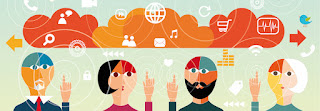SAFE (Scaled Agile Framework )
is an Agile software development framework designed by Scaled Agile, Inc. It consists of a knowledge base of integrated patterns intended for enterprise-scale Lean-Agile development.
SAFe synchronizes alignment, collaboration, and delivery for large numbers of agile teams.
But first let's remember some basic Agile concepts...
http://agilemanifesto.org/
and... THE AGILE PRINCIPLES
These values are important because in the Agile culture, our main focus is on value creation instead of on single process compliance. For this reason, in the Agile Methods, we have a lightweight approach in terms of the software requirements discipline.
SAFe is organised into three levels: Team, Program and Portfolio. Each level has a set of roles, events and rules. We can use this structure to help the way to scale the content into big companies or into big products/projects
In a large structure we have:
Theme - Represent the set of initiatives which drive the enterprises investment in systems, products and applications."
Epics - Epic, then, represent the highest level expression of a customer need as this hierarchical graphic shows.
Features - Are services provided by the system that fulfill stakeholder needs.
It's important to note that one theme can involve many Epics and each Epic may be detailed into many Features and each Feature has many User Stories. We can see this behavior in the image below.
Each kind of item is discovered and managed at each level of SAFe. Thus, at Portfolio level, we have Themes and Epics. At this level, there is an artifact called Portfolio Backlog. The Portfolio Backlog is a prioritised list of Epics.
At Program level, we work with Features derived from Epics. These Features are also organised and prioritised into the artifact known as Program Backlog. At the end, we have the Team Level. At this level, the teams can breakout each Feature in many User Stories.
Principles of SAFe
SAFe is based on a number of immutable, underlying Lean and Agile principles. These are the fundamental tenets, the basic truths and economic underpinnings that drive the roles and practices that make SAFe effective:
1. Take an economic view
2. Apply systems thinking
3. Assume variability; preserve options
4. Build incrementally with fast, integrated learning cycles
5. Base milestones on objective evaluation of working systems
6. Visualize and limit WIP, reduce batch sizes, and manage queue lengths
7. Apply cadence (timing), synchronize with cross-domain planning
8. Unlock the intrinsic motivation of knowledge workers
9. Decentralize decision-making
The SAFe framework www.scaledagileframework.com
SAFe: differences between Nexus and LeSS
Nexus:
- Scrum.org's framework for scaling Scrum
- Intended for 3-9 Scrum teams
- Adds an "Integration Team" that focuses on dependencies, interoperation, and integration between Scrum teams. "The Nexus Integration Team consists of individuals who are skilled in the use of tools and practices associated with scaled development work."
- Simplistically, the Nexus framework takes the various roles and ceremonies of Scrum and adds "Nexus" in front of them. For example, "the Nexus Daily Scrum".
- Nexus is heavily focused on this integration/SOS role. It does not seem to cover other organizational considerations like Org Structure the way that LeSS does.
------------------------------------------------------------
LeSS (Large-Scale Scrum)
LeSS is a product development framework that extends Scrum with scaling rules and guidelines without losing the original purposes of Scrum.
LeSS stands for the general techniques for scaling Scrum and Agile Development to more than one team and it is the name for the basic LeSS Framework which works up-to around 8 teams.
The second LeSS Framework is named "LeSS Huge" and introduces additional scaling elements for development up to hundreds of developers.
LeSS can be thought of as regular Scrum applied in multiple levels to suit large-scale development: it is a minimal framework that offers a high degree of flexibility at implementation. It is non-prescriptive, and merely gives suggestions.
LeSS builds on “basic” Scrum in that it recommends organizing several feature teams under one Product Owner (PO).
Framework-2, also referred to as LeSS Huge, then adds further APOs (Area POs) to enable scaling. Teams are coordinated with Sprint Planning meetings, and further meetings may be added to help collaboration.
LeSS is a great choice for small organizations that are growing quickly, and are looking for a framework that helps scale Scrum along with their organization. It allows flexibility over rules, which is both its advantage and its major risk factor: large enterprises may shy away from it in favor of a more structured framework.
LeSS Huge Framework









Comentarios
Publicar un comentario